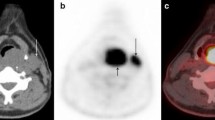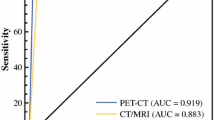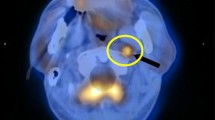Abstract.
While fluorine-18 2-fluoro-2-deoxy-D-glucose (FDG) positron emission tomography (PET) is helpful in the pretherapeutic evaluation of head and neck cancer, it is only available in selected centres. Therefore, single-photon emission tomography (SPET) tracers would be desirable if they were to demonstrate tumour uptake reliably. This multitracer study was performed to evaluate the pretherapeutic uptake of the SPET tracers iodine-123 α-methyl-L-tyrosine (IMT) and technetium-99m hexakis-2-methoxyisobutylisonitrile (99mTc-MIBI) in primary carcinomas of the hypopharynx and larynx and to compare the results with those of FDG PET. We examined 22 fasted patients (20 male, 2 female, mean age 60.5±10.2 years) with histologically confirmed carcinoma of the hypopharynx (n=9) or larynx (n=13), within 1 week before therapy. In 20 patients a cervical PET scan was acquired after intravenous injection of 232±43 MBq 18F-FDG. Data analysis was semiquantitative, being based on standardised uptake values (SUVs) obtained at 60–90 min after injection. After injection of 570±44 MBq 99mTc-MIBI, cervical SPET scans (high-resolution collimator, 64×64 matrix, 64 steps, 40 s each) were obtained in 19 patients, 15 and 60 min after tracer injection. Finally, 15 min after injection of 327±93 MBq 123I-IMT (medium-energy collimator, 64×64 matrix, 64 steps, 40 s each) SPET scans were acquired in 15 patients. All images were analysed visually and by calculating the tumour to nuchal muscle ratio. Eighteen of 20 (90%) carcinomas showed an increased glucose metabolism, with a mean SUV of 8.7 and a mean carcinoma to muscle ratio of 7.3. The IMT uptake was increased in 13 of 15 (87%) patients, who had a mean carcinoma to muscle ratio of 2.9. Only 13 of 19 (68%) carcinomas revealed pathological MIBI uptake, with a mean tumour to muscle ratio of 2.2 and no significant difference between early and late MIBI SPET images (P=0.23). In conclusion, in the diagnosis of primary carcinomas of the hypopharynx and larynx, IMT SPET achieved a detection rate comparable to that of FDG PET. IMT SPET was clearly superior to MIBI SPET in this population. A further evaluation of the specificity of IMT in a larger number of patients appears justified.
Similar content being viewed by others
Author information
Authors and Affiliations
Additional information
Received 1 August and in revised form 16 October 2001
Electronic Publication
Rights and permissions
About this article
Cite this article
Henze, M., Mohammed, A., Mier, W. et al. Pretreatment evaluation of carcinomas of the hypopharynx and larynx with 18F-fluorodeoxyglucose, 123I-α-methyl-L-tyrosine and 99mTc-hexakis-2-methoxyisobutylisonitrile. Eur J Nucl Med 29, 324–330 (2002). https://doi.org/10.1007/s00259-001-0703-3
Published:
Issue Date:
DOI: https://doi.org/10.1007/s00259-001-0703-3




